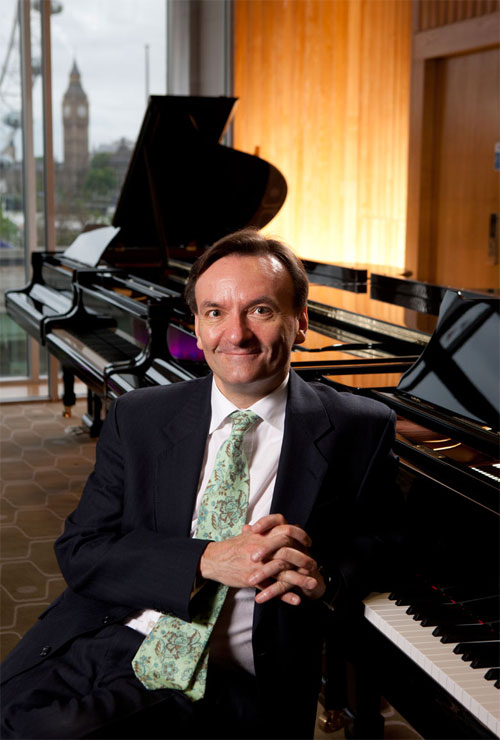Pianist Hough returns with distinctive grace and bravura

Stephen Hough performed a recital in Coral Gables Tuesday night for Friends of Chamber Music. Photo: Andrew Crowley
While some pianists place hard-driving virtuosity over musical subtlety and others take a more intellectual approach to music making, Stephen Hough is that rare artist who combines all of those interpretive attributes in near-perfect proportion.
A small but wildly enthusiastic audience greeted Hough’s return at the season-opening concert of Friends of Chamber Music Tuesday night at Coral Gables Congregational Church. True to form, Hough presented an uncompromising program that eschewed oft-played repertoire staples.
There is little of Schubert’s Viennese gemütlich charm in his Sonata in A minor, D.784, a score that presages Beethoven in its drama and power. In three compact movements, Schubert’s abundant melodic gifts take a darker turn. Hough splendidly encompassed the hairpin changes of meter and alliteration of loud and soft dynamics in the first movement. Drawing warm, rounded tone from the church’s excellent Bösendorfer, he even managed to bring some lighter turns amid the music’s dark aura.
In the Andante, Hough shaped the principal melody with simple eloquence. His figurations in the right hand over repetition of the theme in the left were delicately etched and evenly balanced. The final Allegro vivace emerged alternately poetic and fierce. Hough dispatched the rapid-fire sections with every note transparent and strongly felt.
Franck’s Prelude, Chorale and Variations finds the Belgian composer at his most somber. Hough brought clarity to the rumbling opening pages that can often sound murky. The score’s main theme was given massive, almost orchestral sonority. In the chorale, the hand crossings were smoothly articulated and there was vivid detailing of the emerging melodic lines. The fugal voices in the final section came through with incisive accuracy.
Hough is also a composer and his Piano Sonata III (“Trinitas”) proved both imaginative and diverting. He told the audience that his aim, in this work, was to rediscover tonality through the atonal system. Hough utilizes atonality as an underpinning to the thematic motifs of the three continuous movements.
After an initial Lento in which melodic fragments emerge from chime-like chords, a bouncy Allegro reveals jazz influences. The bristling lightness of Hough’s playing as his hands swept across the keyboard displayed his versatility at diverse musical idioms. A three-note chorale motif in the concluding Andante turns into a theme that is similar to the hymn “Holy, Holy, Holy.” The repeated arpeggios in the transition between the second and third movements were finely articulated and Hough gave an authoritative performance of his appealing work.
Liszt’s Valse Oubliée Nos. 1 and 2 provided a breezy interlude. These pieces are as close as Liszt ever got to writing salon music. Hough’s speedy renditions added a modernist touch to the Chopinesque lines. In the second waltz, the pauses were perfectly timed, giving a quirky twist to the otherwise bright dance rhythms.
Without pause Hough proceeded into Liszt’s Transcendental Etude No. 11 (“Harmonies du Soir”),bringing a crescendo of pianistic sound to the big-boned romantic thunder. In the Etude No. 10, Hough met Liszt’s bombast on its own terms. He impressively conquered the knuckle-busting octaves and assayed the coda at a breakneck pace.
Encores included Hough’s own splashy fantasia on the Australian ditty “Waltzing Matilda” but the real gem was Manuel Ponce’s Intermezzo, an entrancing melody played with restraint and grace.
The Friends of Chamber Music season continues with pianist Denis Kozhukhin playing works by Handel, Brahms, Weber and Albéniz 8 p.m. October 17 at Coral Gables Congregational Church. miamichambermusic.org.
Posted in Performances
Leave a Comment
Wed Sep 28, 2016
at 11:29 am
No Comments